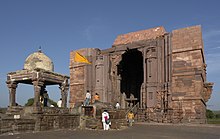Paramara
The Paramara (also: Pavar , Parmar ) were a medieval ruling dynasty in north-west India (8th – 14th centuries).
history
The Paramara originally belonged to the Gurjara tribe of the Thar Desert and were raised to full nobility in the fire-cleaning ceremony on Mount Abu (approx. 747) together with the Pratihara , Chauhan and others. Since then they have been counted among the Rajputs of the Agnivamsa, ie fire clans, which is also reflected in their inscriptions. With the expansion of the (Gurjara-) Pratihara in northern India, the Paramara under Krishnaraja were able to establish themselves in Malwa (today western Madhya Pradesh ) around 792/825 .
First of all, they had to defend themselves against the attacks of the Rashtrakuta or recognize them as overlords. In 972, however, Siyaka II. Harshasimha (r. 948–974) succeeded in defeating the Rashtrakuta emperor Amoghavarsha IV, killing him and looting his capital, Manyakheta. This was followed by the fall of the Rashtrakuta by their governor Tailapa Ahavamalla (r. 973-997), who restored the Chalukya empire. Tailapa was also able to push back the Paramara and their king Vakpati II Munja (r. 974–995), a son of Siyaka II, to arrest and to have him executed in 995.
Vakpati's brother and successor Sindhuraja Navasahasanka (r. 995-1010 / 21) restored the Paramara kingdom. It reached its climax under his son Bhoja I (r. 1010 / 21-1065), who is considered a kind of ideal Hindu king. Bhoja has an excellent reputation to this day as a writer of sophisticated literature and encyclopedias ( medicine , architecture , etc.), even if part of his work can certainly be ascribed to anonymous collaborators. He was allied with the Shilahara kings (in the Bombay area ) and subordinated himself to the Solankis in Gujarat, whose famous pilgrimage site Somnath had been sacked in 1026 by the Muslims under Mahmud of Ghazni . When he sought supremacy in northern India, he was defeated by an alliance of neighboring princes (the Kalachuri Karna, the Chalukya Someshvara I, the Chandella Kirtivarman and the Solanki Bhima I) and died while conquering his capital, Dhara . The empire suffered a period of weakness as a result, compounded by quarrels for the throne.
The participation in the alliance against the Kalachuri Karna (around 1070) allowed Bhoja's successors Lakshmidhara and Udayaditya to re-establish the Paramara empire and to build the Nilakantha temple in Udaipur . With the capture of Paramara Yasovarman (approx. 1136/37), however, the rise of the Solanki (also: Chaulukya) of Gujarat began and the empire disintegrated into small states. In the 13th century the Muslims threatened Malwa and in 1234 the Sultan Iltutmish conquered the country as far as Ujjain . In the last decade of the century, the sultans finally resumed expansion. The last Paramara king, Harananda, was defeated in 1305 by an army of the Delhi Sultan Ala ud-Din Khalji under the governor 'Ain-ul-Mulk of Multan .
buildings
The kings and high officials of the Paramara dynasty built numerous Jain and Shiva temples (e.g. in Arthuna or in Bhojpur ); However, these were in the 13./14. Destroyed by Islamic army units in the 19th century . Large water regulation systems were also built (e.g. Mithi-Vav step wells ).
Paramara kings
in Ujjain :
- Upendra Krishnaraja (approx. 792/825)
- Vairisimha I.
- Siyaka I.
- [unknown]
- Vakpati I. (approx. 900)
- Vairisimha II. (C. 919–948, ed.)
- Siyaka II. Harshasimha (948–974, ed.)
- Vakpati II. Munja (974-995)
- Sindhuraja (995-1010 / 21)
- Bhoja I. (1010 / 21– approx. 1065)
- Jayasimha I. (-1069)
- Udayaditya (1070-1087)
- Lakshmanadeva (Jugga Deva, 1087-1094)
- Naravarmandeva (ca.1094–1133)
- Yaso Varman (1133–1142)
- Jaya Varman I (1142–1143)
- Ballaha (1143–1150 / 1)
- (1150–1175 Solanki governor Rajyapala)
- Vindhya Varman (1175-1194)
- Subhata Varman (1194-1209)
- Arjuna Varman I (1210-1215 / 8)
- Deva Pala (1215 / 8-1238)
- Jaitugi Deva (1239-1255)
- Jayasimha II (Jayavarman, 1255-1274)
- Arjuna Varman II (1274-128?)
- Bhoja II (approx. 1283)
- Mahlaka Deva (129? -XI.1305)
Branch line in Bhopal :
- Lakhmi Varman ca.1144 (son of Yasovarman)
- Harischandra approx. 1157/78
- Udaya Varman about 1189
Another branch line existed 9-12. Century in Vagada.
literature
- Benjamin Walker: Hindu World , Vol. 2, London 1968. Keyword: Paramāra (p. 186)

